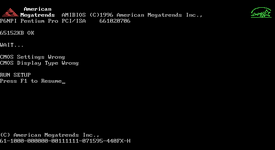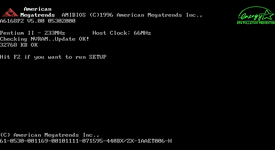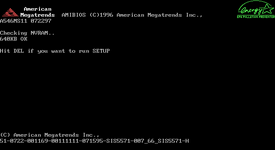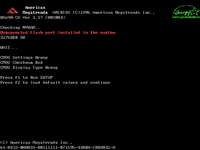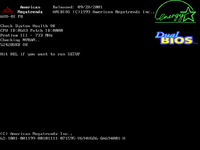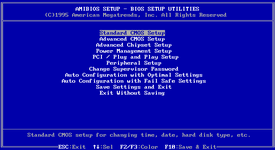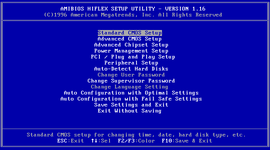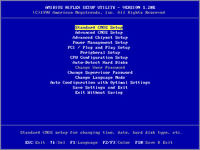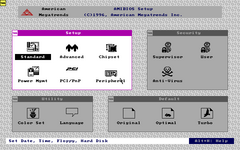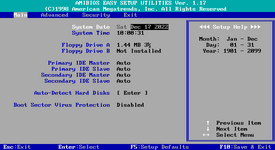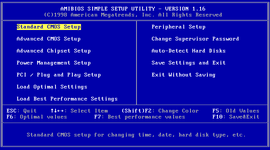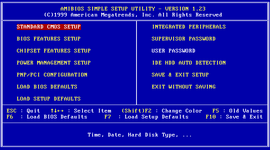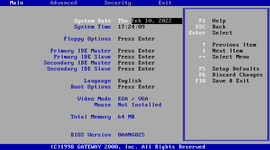mNo edit summary |
No edit summary |
||
| (12 intermediate revisions by 2 users not shown) | |||
| Line 1: | Line 1: | ||
[[File:AMIBIOS 6 POST screen.png|thumb|The POST screen used by early AMIBIOS 6, although some slight changes have occurred over years]] | [[File:AMIBIOS 6 POST screen.png|thumb|The POST screen used by early AMIBIOS 6, although some slight changes have occurred over years]] | ||
AMIBIOS 6 is a | '''AMIBIOS 6''' is a family of various versions of [[AMIBIOS]] developed by [[American Megatrends]] between 1995 and 2001. These versions are mostly known with the core date <code>071595</code> (July 15, 1995) in the identification string, however some newer cores may also use other dates such as <code>071599</code> (July 15, 1999). | ||
Early versions | It was mainstream for a very long time. It was the newest AMIBIOS core version from July 1995 up until 1999 when the earliest known instances of [[AMIBIOS 07.00.xx]] were released, although it was still widely used by most manufacturers until April 2001 when it was finally replaced by [[AMIBIOS 07.00.10]]. | ||
Early versions of AMIBIOS 6 still could only detect up to 32 GB hard drives, however in around 1999 this limit was increased to 64 GB. AMIBIOS 6 was also the first version of AMIBIOS to natively include built-in PnP (Plug and Play) support, a hardware detection technology standardized with [[Microsoft Windows 95]]. Although some later instances of [[AMIBIOS 5]] also had add-on ROMs for PnP support. | |||
== POST screen == | == POST screen == | ||
As AMIBIOS 6 was in use for a very long time, | As AMIBIOS 6 was in use for a very long time, changes to the POST screen (along with other parts of the BIOS) were made over time. The EPA (Energy Star certification logo) can also change depending on the preference of OEMs and the core version. | ||
<gallery mode="packed" widths=180px heights=100px> | <gallery mode="packed" widths="180px" heights="100px"> | ||
File:AMIBIOS_6_POST_small_EPA.png|POST screen with small EPA, same EPA also used by AMI WinBIOS, often used by ones that have WinBIOS Setup Utility | File:AMIBIOS_6_POST_small_EPA.png|POST screen with small EPA, same EPA also used by AMI WinBIOS, often used by ones that have WinBIOS Setup Utility | ||
File:AMIBIOS 6 POST EPA on right.png|POST screen with EPA on right corner | File:AMIBIOS 6 POST EPA on right.png|POST screen with EPA on right corner | ||
| Line 15: | Line 17: | ||
== Setup Utility == | == Setup Utility == | ||
Unlike AMI WinBIOS and AMIBIOS 5, AMIBIOS 6 included a variety of setup utilities for use by OEMs | Unlike [[AMI WinBIOS]] and [[AMIBIOS 5]], AMIBIOS 6 included a variety of setup utilities for use by OEMs. Early versions only offered the WinBIOS (resembling the AMIBIOS 4 and 5 setup) and Hi-Flex (resembling the AMI Hi-Flex BIOS setup) setup utilities, while Easy Setup (resembling the [[AMI Hi-Flex BIOS#Intel fork|Intel AMI Hi-Flex fork setup]]) and Simple Setup (resembling the [[Award EliteBIOS]] setup) were also introduced later, former in 1997 and latter in 1998. | ||
<gallery mode="packed" widths= | <gallery mode="packed" widths="180" heights="100"> | ||
File:AMIBIOS 6 Hi-Flex Setup Utility (Early).png|Early Hi-Flex Setup Utility (1995), does not mention Hi-Flex | File:AMIBIOS 6 Hi-Flex Setup Utility (Early).png|Early Hi-Flex Setup Utility (1995), does not mention Hi-Flex | ||
File:AMIBIOS 6 Hi-Flex Setup Utility (Late).png|Later Hi-Flex Setup Utility (1996-2001), | File:AMIBIOS 6 Hi-Flex Setup Utility (Late).png|Later Hi-Flex Setup Utility (1996-2001), mentioning Hi-Flex | ||
File:AMIBIOS 6 Hi-Flex Setup Utility (VGA).png|Hi-Flex Setup Utility in VGA resolution, | File:AMIBIOS 6 Hi-Flex Setup Utility (VGA).png|Hi-Flex Setup Utility in VGA resolution, often was used on versions with Chinese or Japanese language support. | ||
File:AMIBIOS 6 WinBIOS Setup Utility.png|WinBIOS Setup Utility | File:AMIBIOS 6 WinBIOS Setup Utility.png|WinBIOS Setup Utility | ||
File:AMIBIOS 6 Easy Setup Utility.png|Easy Setup Utility | File:AMIBIOS 6 Easy Setup Utility.png|Easy Setup Utility | ||
File:AMIBIOS 6 Simple Setup Utility (Early).png|Early Simple Setup Utility | File:AMIBIOS 6 Simple Setup Utility (Early).png|Early Simple Setup Utility | ||
File:AMIBIOS 6 Simple Setup Utility (Late).png| | File:AMIBIOS 6 Simple Setup Utility (Late).png|Late Simple Setup Utility | ||
File:AMIBIOS 6 Gateway Setup Utility.png|Setup Utility used by some Gateway 2000/Advanced Logic Research (ALR) | File:AMIBIOS 6 Gateway Setup Utility.png|Setup Utility used by some Gateway 2000/Advanced Logic Research (ALR) motherboards, believed to be made by Intel for an internal development version of [[AMIBIOS 6#Intel fork|their AMIBIOS 6 fork]] | ||
</gallery> | </gallery> | ||
== Bugs and quirks == | == Bugs and quirks == | ||
'''''NOTE:''' The following issues may not represent every instance of AMIBIOS 6 and may vary depending on the OEM's implementation and the core version.'' | |||
People have reported Plug and Play related issues on early AMIBIOS versions with Plug and Play support (assumed to be AMIBIOS 6). However the issues were later said to be fixed in around 1997.<ref>https://forums.anandtech.com/threads/ami-or-award-any-preferences.345180/post-95507</ref> | |||
AMIBIOS 6 also | Early versions of AMIBIOS 6 also have a bug with their El Torito (CD boot) implementation where Windows NT 5.x (Windows 2000, XP etc.) disks may not be bootable. Attempting to boot such a disk on these versions will likely result in an NTLDR is missing error, regardless of used disc. | ||
Thomas Pabst of Tom's Hardware | Thomas Pabst of Tom's Hardware has also reported issues regarding IRQ routing with AMIBIOS 6 (mistakenly referred to as "AMI WinBIOS" due to used setup utility) on various Intel 440BX chipset motherboards with it, calling it "a big disappointment".<ref>https://www.tomshardware.com/reviews/review-slot-1-motherboards-intel-440bx-chipset,67.html</ref> | ||
== Intel fork == | == Intel fork == | ||
| Line 38: | Line 42: | ||
''Main page: [[List of BIOS and UEFI firmwares used by Intel motherboards]]'' | ''Main page: [[List of BIOS and UEFI firmwares used by Intel motherboards]]'' | ||
Intel forked AMIBIOS 6 subcore <code>071595</code> in around 1998 and began using it on their motherboards. This fork also used an unusual <code>063200</code> core number (last for regular AMIBIOS 6 was <code>063100</code>. It was | Intel forked AMIBIOS 6 subcore date <code>071595</code> in around 1998 and began using it on their motherboards. This fork sometimes also used an unusual <code>063200</code> core number (last for regular AMIBIOS 6 was <code>063100</code>). It was later replaced with [[AMIBIOS 8#Intel fork|the AMIBIOS 8 fork]] in around 2003. | ||
Revision as of 08:35, 12 May 2024
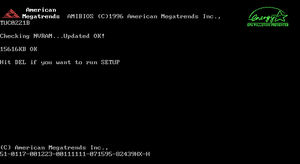
AMIBIOS 6 is a family of various versions of AMIBIOS developed by American Megatrends between 1995 and 2001. These versions are mostly known with the core date 071595 (July 15, 1995) in the identification string, however some newer cores may also use other dates such as 071599 (July 15, 1999).
It was mainstream for a very long time. It was the newest AMIBIOS core version from July 1995 up until 1999 when the earliest known instances of AMIBIOS 07.00.xx were released, although it was still widely used by most manufacturers until April 2001 when it was finally replaced by AMIBIOS 07.00.10.
Early versions of AMIBIOS 6 still could only detect up to 32 GB hard drives, however in around 1999 this limit was increased to 64 GB. AMIBIOS 6 was also the first version of AMIBIOS to natively include built-in PnP (Plug and Play) support, a hardware detection technology standardized with Microsoft Windows 95. Although some later instances of AMIBIOS 5 also had add-on ROMs for PnP support.
POST screen
As AMIBIOS 6 was in use for a very long time, changes to the POST screen (along with other parts of the BIOS) were made over time. The EPA (Energy Star certification logo) can also change depending on the preference of OEMs and the core version.
-
POST screen with small EPA, same EPA also used by AMI WinBIOS, often used by ones that have WinBIOS Setup Utility
-
POST screen with EPA on right corner
-
POST screen with EPA on top right corner
-
POST screen in VGA resolution (640x480), also often used on Chinese and Japanese BIOSes
-
POST screen in VGA resolution and with different EPA, used by some Gigabyte motherboards
Setup Utility
Unlike AMI WinBIOS and AMIBIOS 5, AMIBIOS 6 included a variety of setup utilities for use by OEMs. Early versions only offered the WinBIOS (resembling the AMIBIOS 4 and 5 setup) and Hi-Flex (resembling the AMI Hi-Flex BIOS setup) setup utilities, while Easy Setup (resembling the Intel AMI Hi-Flex fork setup) and Simple Setup (resembling the Award EliteBIOS setup) were also introduced later, former in 1997 and latter in 1998.
-
Early Hi-Flex Setup Utility (1995), does not mention Hi-Flex
-
Later Hi-Flex Setup Utility (1996-2001), mentioning Hi-Flex
-
Hi-Flex Setup Utility in VGA resolution, often was used on versions with Chinese or Japanese language support.
-
WinBIOS Setup Utility
-
Easy Setup Utility
-
Early Simple Setup Utility
-
Late Simple Setup Utility
-
Setup Utility used by some Gateway 2000/Advanced Logic Research (ALR) motherboards, believed to be made by Intel for an internal development version of their AMIBIOS 6 fork
Bugs and quirks
NOTE: The following issues may not represent every instance of AMIBIOS 6 and may vary depending on the OEM's implementation and the core version.
People have reported Plug and Play related issues on early AMIBIOS versions with Plug and Play support (assumed to be AMIBIOS 6). However the issues were later said to be fixed in around 1997.[1]
Early versions of AMIBIOS 6 also have a bug with their El Torito (CD boot) implementation where Windows NT 5.x (Windows 2000, XP etc.) disks may not be bootable. Attempting to boot such a disk on these versions will likely result in an NTLDR is missing error, regardless of used disc.
Thomas Pabst of Tom's Hardware has also reported issues regarding IRQ routing with AMIBIOS 6 (mistakenly referred to as "AMI WinBIOS" due to used setup utility) on various Intel 440BX chipset motherboards with it, calling it "a big disappointment".[2]
Intel fork
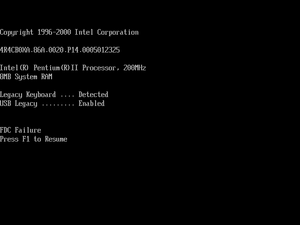
Main page: List of BIOS and UEFI firmwares used by Intel motherboards
Intel forked AMIBIOS 6 subcore date 071595 in around 1998 and began using it on their motherboards. This fork sometimes also used an unusual 063200 core number (last for regular AMIBIOS 6 was 063100). It was later replaced with the AMIBIOS 8 fork in around 2003.
